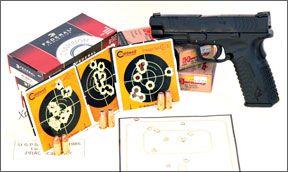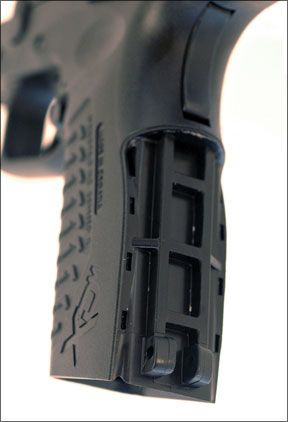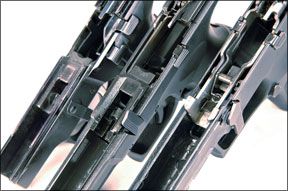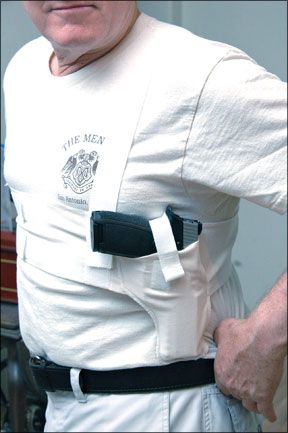Since the September 2010 issue of Gun Tests, we referred to our evaluation of two similar 1911 45s as being something of a rarity. That’s because the guns were essentially a different interpretation of the same design. More often, we compare a roster of test guns that, despite being of the same caliber and approximately the same size, end up demanding widely different skill sets to operate.

In this test we once again evaluate two closely related firearms chambered for 45 ACP ammunition. They are the $709 Springfield Armory XDM 45 XDM945BHC and the $712 SIG Sauer P250 45 Full Size 250F-45-BSS. Both pistols are full-sized guns with polymer frames and a barrel length of 4.5 inches. Each gun offers an accessory rail, low-mount sights, double-column magazines, and a measure of ambidextrous features.
On the surface it would seem that this was indeed another “apples to apples” test. But one noteworthy difference between the two pistols puts these guns in different categories, we believe. The trigger on the XDM 45 requires a takeup and press that was much shorter than that of the SIG Sauer P250 45. That was because the striker inside the XDM 45 is primed to a point just short of ignition by movement of the slide. However, the XDM 45 is categorized as a double-action pistol. This is based on the actions of pressing the trigger renders final compression and release of the striker. In a more obvious display of double-action form, the SIG Sauer operator has almost complete control of the ignition cycle. Pressing the P250’s trigger rearward results in nearly a 1:1 ratio in terms of lifting the hammer and dropping it on the firing pin. Some shooters may find this difference too much to overcome, smashing our presentation as a test of similar guns. But as shown by the results of our rapid-fire tests, our staff found that both triggers could be operated quickly and effectively.
Our tests for accuracy were performed from a bench at the Top Gun of Texas indoor shooting range. We took full advantage of Top Gun’s 20-yard bays and the slick mechanical target retrieval system recently installed by Action Target. Away from the heat and marauding showers in the Texas outdoors, we liked the privacy and safety afforded by the sizable ballistic barriers that separated us from other shooters. Accuracy testing was a slow-fire exercise, but we used an electronic timer to record our first shot and total elapsed times during our two action tests. Our first action test was performed from the 7-yard line with the shooter holding the gun in both hands and the front sight held at the lower edge of the shooter’s peripheral vision. Our target was the IPSC-P (paper) targets from www.letargets.com. The action consisted of firing two shots to the body (a 5- by 9-inch rectangle A-zone), and one to the head. The head area measured 6.9 by 6.3 inches overall with a 4-inch-wide by 2-inch-tall A-zone, which on a human target terms would mask the eyes. We recorded ten separate runs.
In our second action test we wanted to know more about keeping the gun mounted in the hand throughout rapid fire. So, for this test the start position was with the gun directly on target held only in the shooter’s strong hand. This meant our right-handed test shooter fired holding the gun with only the right hand. The IPSC-P target was placed 5 yards downrange and we concentrated on head shots only. Five runs of two shots each were recorded.

Test ammunition included 185-grain and 200-grain Hornady Custom XTP jacketed hollowpoint rounds. We also tested with the least expensive rounds we could find. They were Federal 230-grain FMJ rounds purchased for less than $17/50 from Walmart. Our action tests were performed using the 200-grain Hornady ammunition. Here’s how we rated them:
Springfield Armory XDM 45 XDM945BHC 45 ACP, $709
Whereas the SIG Sauer P250 design is a radical departure from previous models, the XDM series of pistols represent a refinement of an existing product. Changes from the XD pistols include a cosmetic change to the slide, a more squared profile of the grip and disassembly without the necessity of pressing the trigger. The XDM arrived in a distinctive attach case filled with holster and magazine pouch, magazine loader, two additional 13-round magazines, and two alternate backstraps of different sizes and shapes. Similar accessory packs are available with the XD pistols, but most XDM pistols operate from higher-capacity magazines. Our XDM was all black, but a two-tone model is available for $771. In either case, the XDM pistols cost more, prompting us to point out the following. In a recent attempt to establish an economy line, Smith & Wesson introduced the SD series as a less expensive alternative to the M&P polymer pistol. In a somewhat opposite move, Springfield Armory’s XDM now places the XD series in the position of being their economy pistol. The XD and the XDM pistols arrive completely assembled from Croatia. But they are function-fired at the Geneseo, Illinois, facility before being shipped.
Both the XD and XDM pistols feature ambidextrous magazine-release buttons located just above the undercut to the trigger guard. But the XDM slide release and the takedown levers have been given a makeover to blend in with the sleek profile of the weapon. The XD and XDM pistols are the only pistols to our knowledge that include a grip safety, other than the 1911 design. The extra cost of the XDM also goes for an upgrade to the sights, including the rear unit that extended sight radius to the rear plane of the slide.
The XD pistols have been a success based on simplicity and ergonomic appeal. With the introduction of the XDM 45, now both series of pistols are offered in the most popular calibers (9mm, 40 S&W, and 45 ACP). In our July 2008 issue we recommended the XD45 to anyone with medium to large hands. But the interchangeable back straps of the XDM 45 were more effective in placing the trigger finger in correct relation to the face of the trigger, and this should help accommodate a wider range of hand sizes. In addition, our staff said that it was the contour of the M-style side panels that did more to control the recoil of 45 ACP rounds, including muzzle flip and torque.

From the 20-yard bench we were pleased by the consistent accuracy of the XDM 45. Average Group Radius was recorded as 0.87 inch, 0.64 inch, and 0.92 inch for the 185-grain, 200-grain, and 230-grain rounds, respectively. (The on-paper difference was slight, although cost varied from as little as 34 cents per round to as much as 91 cents per shot.) The largest-diameter 10-shot group fired using the Federal budget rounds measured 2.47 inches across, equal to the SIG Sauer P250’s best Maximum Spread.
The short press of the XDM trigger and the improved grip made firing our actions tests fun and simple. From the 7-yard line, only our first few careful runs placed two shots to the body and one to the head in an elapsed time of more than 2 seconds. Like on the original XD, we think the XDM-series pistols are very easy to learn. On average, runs 1-5 took .89 seconds for the first shot and 2.09 seconds to complete. Runs 6-10 produced average elapsed times of 0.81 seconds for the first shot and 1.82 seconds of total time. As hard as we were pushing, the target showed 20/20 hits neatly inside the lower A-zone. The head area also contained 10/10 expected hits.
Firing strong hand only from 5 yards, our two-shot runs were completed in an average elapsed time of 1.82 seconds. First shots were fired at the 0.97-second mark. That the same advantage in speed we saw firing the XDM freestyle did not specifically translate to a faster time when firing the gun held with only our strong hand was a surprise. One hit was pushed to the left, and two more shots landed low of the head area on our target.
Our Team Said: So many pistols, polymer or otherwise, have been adapted from 9mm to more powerful ammunition. Some of these pistols have been able to maintain their original level of performance, but at the price of making the shooter work much harder. That is where the Springfield Armory XDM 45 fully succeeds because this pistol was actually more fun to shoot than the smaller caliber models we’ve tested. We think the XDM’s changes to the original design makes this gun more 45-worthy than many other pistols we’ve tried.
SIG Sauer P250 45 Full Size 250F-45-BSS 45 ACP, $712
The SIG Sauer P250 45 is a handsome, robust-looking gun that was a pleasure to hold. The polymer frame ran the length of the slide, including a taper at the muzzle end finishing off the five-slot accessory rail. The rear upper portion of the grip frame extended an additional 0.75 inch beyond the rear face of the slide to add support at the web of the hand. The grip was thinnest along the circumference that is wrapped by the thumb and trigger finger. The rest of the grip offered a slight swell, with panels of stippling molded into the polymer on all four sides. The 10-round magazine fit flush on the edges but added about 0.25 inch to the length of the front strap. Only one magazine was supplied, and extra magazines cost a hoo-boy $45. The magazine well was not enhanced on either pistol. But due to the size of each gun’s well and the inherent taper of double-column magazines, insertion was rapid and clean. A section of the P250’s magazine well was relieved at the base of each side panel to provide grip should the magazine need to be ripped from the receiver.

The P250 pistols were designed to be a modular unit consisting of a grip frame, the firing module that included the rails to support the slide, plus the top-end unit, which housed the barrel and sights plus the firing pin and extractor. The concept was to provide alternate grip sizes and trigger reach to accommodate different size hands. The 45 ACP model P250 is only available with the medium or the large grip frame (as tested). The firing unit was actually the serialized weapon, so once you own a complete P250 it is possible to order an alternate grip frame without having to register it through an FFL licensee. Additional modules cost $376. Swapping out the frames should be easy enough so that one version could conceivably be used as a duty sidearm but then changed to a smaller, more concealable package. The P250 included components from several different countries, the provenance of which SIG Sauer was unwilling to divulge. Final assembly was in the United States.
One interesting note about our comparison with the Springfield Armory XDM is the XDM actually cycles utilizing a locking block similar to the classic SIG Sauer designs found in the P226/P229 models. The P250 models cycle on a cross bar. Another interesting comparison is how each gun begins its takedown. After the slide is locked back, the SIG Sauer takedown lever is swung downward. The XDM takedown lever is rotated upward.
The P250 utilizes a multi-filament recoil spring. This is typical of SIG Sauer pistols, but the guide rod was unique. The guide rod was steel with a telescopic contour. But the rod is one solid piece, and does not compress. The slide-release levers were ambidextrous, and the magazine release can be changed to either side. The sights were low-mount non-luminous white dots. The front sight was dovetailed into place from the side, and the rear unit was pressed into place from the rear.
From the driver’s seat our shooter reported that the long, long trigger pull took some getting used to. Firing from the bench, it seemed like we ran out of concentration before we ran out of trigger pull. We needed to become more familiar with the P250’s trigger. Generally speaking, this is best accomplished by shooting from the bench, but in the case of the P250 we were better able to familiarize ourselves firing offhand. After a stand-and-shoot practice session, we were able to return to the bench with a more compact trigger press. We also recommend taking advantage of the SIG’s DAO system that lends itself well to dry firing. Steadying the sights on a small point, you can pull the trigger repeatedly without having to break grip and work the slide.
From the bench, our P250 45 showed a clear preference for the 185-grain Hornady ammunition. Despite the shape and overall appearance of the 200-grain XTP rounds, results were markedly less satisfying. Ten rounds of 185-grain Hornady Custom rounds grouped easily inside a 2.50-inch circle. Average group radius measured 0.77 inches. The inexpensive Federal 230-grain FMJ rounds produced an AGR of 0.93 inches, but we think we’d stick with just about any round that featured a 185-grain bullet because they felt optimal for this handgun.
From the 7-yard line we found that the P250 45 was a much better rapid-fire shooter than we expected. On the first run our first shot time was recorded at 0.99 seconds after the start signal. But we were able to shave our first shot time to 0.77 seconds after just a few runs. Average first shot time computed to be about 0.85 seconds. Overall elapsed time, including the slow initial time of 2.35 seconds, averaged out to be about 1.95 seconds. But what we found most impressive was that our “two to the body, one to the head” drill showed only one shot left and one shot wide right of the lower A-zone. All 10 shots were inside the head area, and 9 of the 10 shots formed a 4.25-inch group. Firing two-shot strings from 5 yards strong hand only, we suffered failures to feed on the second run firing the 230-grain ammunition. We then switched to the 200-grain Hornady JHP/XTP rounds and completed the exercise without malfunction. Elapsed times averaged 1.89 seconds. First shots were fired at the 1.04-second mark. This was quicker than we thought we would be able to shoot the long double-action trigger. But more practice was needed because we pulled about 40% of our shots low.
Unfortunately, we suffered five malfunctions over the course of our tests. The first one was during our bench session when the slide locked back prematurely with one round of 185-grain Hornady still atop the magazine. A 200-grain round jammed during our strong-hand-only drills. In another instance, one round of the Federal ammunition failed to ignite, despite what appeared to be adequate impact on the primer. The 230-grain rounds jammed the pistol twice during our chronograph session, fired with the pistol held in both hands. Malfunctions occurred when the gun was held strong hand only, in both hands standing unsupported, and in both hands braced against a sandbag rest. Thus, we would discount a weak or faulty grip causing the problem. We tried firing with the magazine in various states of supply, magazine full to magazine on its last round, with no effect one way or the other. All three ammunitions were involved in one malfunction or another. But these same rounds functioned reliably in our other test pistol.
Our Team Said: The SIG Sauer P250 45 seemed like a capable, comfortable-shooting pistol. The long full-time double-action trigger was easier to learn than we had expected. Yes, we could see ourselves far more proficient with this pistol with additional practice. Regarding the malfunctions we experienced, it would have been helpful to have a second magazine to rule out it completely. But we chose to send the pistol back to SIG Sauer for evaluation and repair. The premature lock back was exactly the opposite of a problem we suffered in our February 2009 test of a 9mm compact model P250. That test gun failed to lock back over an empty magazine. Warranty work was handled quickly in that case. Report from SIG Sauer’s warranty repair department regarding the above issues will be forthcoming.































